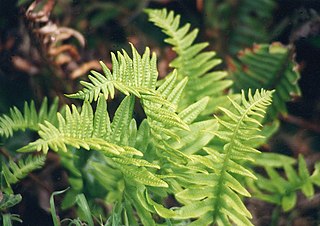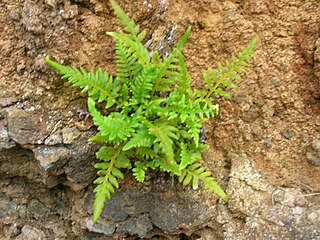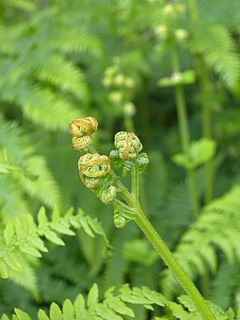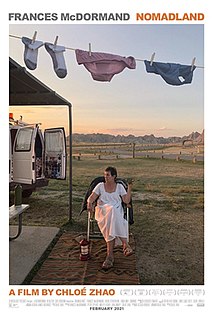
The tree ferns are arborescent (tree-like) ferns that grow with a trunk elevating the fronds above ground level, making them trees. Most tree ferns are members of the "core tree ferns", belonging to the families Cyatheaceae, Dicksoniaceae, Metaxyaceae, and Cibotiaceae in the order Cyatheales. It is estimated that Cyatheales originated in the early Jurassic, and is the third group of ferns known to have given rise to tree-like forms. The others are the extinct Tempskya of uncertain position, and Osmundales where the extinct Guaireaceae and some members of Osmundaceae also grew into trees. In addition there was the Psaroniaceae and Tietea in the Marattiales, which is the sister group to true ferns.

A fern is a member of a group of vascular plants that reproduce via spores and have neither seeds nor flowers. The polypodiophytes include all living pteridophytes except the lycopods, and differ from mosses and other bryophytes by being vascular, i.e., having specialized tissues that conduct water and nutrients and in having life cycles in which the branched sporophyte is the dominant phase. Ferns have complex leaves called megaphylls, that are more complex than the microphylls of clubmosses. Most ferns are leptosporangiate ferns. They produce coiled fiddleheads that uncoil and expand into fronds. The group includes about 10,560 known extant species. Ferns are defined here in the broad sense, being all of the Polypodiopsida, comprising both the leptosporangiate (Polypodiidae) and eusporangiate ferns, the latter group including horsetails, whisk ferns, marattioid ferns, and ophioglossoid ferns.

The order Cyatheales, which includes most tree ferns, is a taxonomic order of the fern class, Polypodiopsida. No clear morphological features characterize all of the Cyatheales, but DNA sequence data indicate the order is monophyletic. Some species in the Cyatheales have tree-like growth forms from a vertical rhizome, others have shorter or horizontal expanding rhizomes.

The New Zealand national netball team, commonly known as the Silver Ferns, represent New Zealand in international netball. The team take their nickname from the Silver Tree Fern, which is an emblem for many New Zealand sports teams. The Silver Ferns were formed in 1938 as a representative New Zealand team to tour Australia. To date, they have been one of the most dominant national netball teams in the world, along with Australia, and have a winning record against most other netball nations. The Silver Ferns are current world champions and ranked second in the INF World Rankings, behind Australia.

The order Polypodiales encompasses the major lineages of polypod ferns, which comprise more than 80% of today's fern species. They are found in many parts of the world including tropical, semitropical and temperate areas.

A pteridophyte is a vascular plant that disperses spores. Because pteridophytes produce neither flowers nor seeds, they are sometimes referred to as "cryptogams", meaning that their means of reproduction is hidden. Ferns, horsetails, and lycophytes are all pteridophytes. However, they do not form a monophyletic group because ferns are more closely related to seed plants than to lycophytes. "Pteridophyta" is thus no longer a widely accepted taxon, but the term pteridophyte remains in common parlance, as do pteridology and pteridologist as a science and its practitioner, respectively. Ferns and lycophytes share a life cycle and are often collectively treated or studied, for example by the International Association of Pteridologists and the Pteridophyte Phylogeny Group.

Diplazium esculentum, the vegetable fern, is an edible fern found throughout Asia and Oceania. It is probably the most commonly consumed fern.

FernGully: The Last Rainforest is a 1992 animated musical fantasy film, directed by Bill Kroyer and scripted by Jim Cox. Adapted from the "FernGully" stories by Diana Young, the film is an Australian and American venture produced by Kroyer Films, Inc., Youngheart Productions, FAI Films and 20th Century Fox. The film stars the voices of Samantha Mathis, Tim Curry, Christian Slater, Jonathan Ward, Robin Williams, and Grace Zabriskie. FernGully is set in an Australian rainforest inhabited by fairies including Crysta, who accidentally shrinks a young logger named Zak to the size of a fairy. Together, they rally the fairies and the animals of the rainforest to protect their home from the loggers and Hexxus, a malevolent pollution entity. Wayne Young, the film's producer, said the film was "blatantly environmental" though made an effort to avoid "preaching".

The Fern Rock Transportation Center is a SEPTA rail and bus station located at 10th Street and Nedro Avenue in the Fern Rock neighborhood of Philadelphia, Pennsylvania. Fern Rock serves as the northern terminus and yard for SEPTA's Broad Street Line, as well as a stop for SEPTA Regional Rail's Lansdale/Doylestown Line, Warminster Line, and West Trenton Line.

Pteridaceae is a family of ferns in the order Polypodiales, including some 1150 known species in ca 45 genera, divided over five subfamilies. The family includes four groups of genera that are sometimes recognized as separate families: the adiantoid, cheilanthoid, pteridoid, and hemionitidoid ferns. Relationships among these groups remain unclear, and although some recent genetic analyses of the Pteridales suggest that neither the family Pteridaceae nor the major groups within it are all monophyletic, as yet these analyses are insufficiently comprehensive and robust to provide good support for a revision of the order at the family level.

The New Zealand National Women's Rugby Union Team, called the Black Ferns, represents New Zealand in Women's Rugby Union, which is regarded as the country's National Sport.The team has won five of the past six Women's Rugby World Cups.

The Polypodiidae, commonly called leptosporangiate ferns, formerly Leptosporangiatae, are one of four subclasses of ferns, and the largest of these, being the largest group of living ferns, including some 11,000 species worldwide. The group has also been treated as the class Pteridopsida or Polypodiopsida, although other classifications assign them a different rank. Older names for the group include Filicidae and Filicales, although at least the "water ferns" were then treated separately.
Katrina Rore is a New Zealand international netball player. Rore is the current vice-captain of the New Zealand national netball team, the Silver Ferns, and plays for the Central Pulse in the ANZ Championship. Rore signed to the New South Wales swifts in the suncorp super netball league in the latter half of the 2018–2019 season following the netball World Cup.
The New Zealand women's national rugby league team, also known as the Kiwi Ferns or New Zealand Kiwi Ferns, represents New Zealand in Women's rugby league. They are administered by the New Zealand Rugby League.

Portia Woodman is a New Zealand rugby union player. She plays fifteen-a-side and seven-a-side rugby union, and is a member of the New Zealand Women's Sevens team and New Zealand Women's National Rugby Union team. Woodman was a member of the New Zealand Women's Sevens team when they won a gold medal at the 2020 Summer Olympics in Tokyo.

Theresa Matauaina Fitzpatrick is a New Zealand rugby union player.
Ruby Tui is a New Zealand rugby union player. She competed internationally when the national rugby sevens team won the silver medal at the 2016 Summer Olympics tournament. She won the gold medal in rugby sevens at the 2020 Summer Olympics.

Nomadland is a 2020 American drama film written, produced, edited and directed by Chloé Zhao. Based on the 2017 nonfiction book Nomadland: Surviving America in the Twenty-First Century by Jessica Bruder, it stars Frances McDormand as a widow who leaves to travel around the United States in her van as a nomad. David Strathairn also stars in a supporting role. A number of real-life nomads appear as fictionalized versions of themselves, including Linda May, Swankie and Bob Wells.















